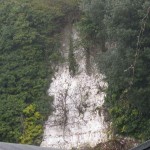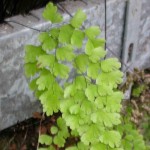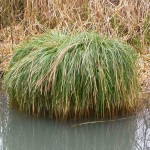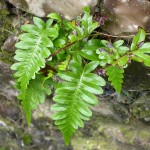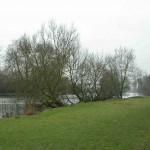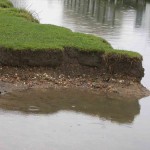On Saturday 19th February, Lesley Dunlop led a field trip to look at the geology of the Shiplake district. Before starting the walk, the botanists had a quick diversion to look at the Maidenhair Ferns which grow under the over-hanging platform at Shiplake Station. The station lies on the Kempton Park Gravel Terrace, laid down about 40 thousand years ago. Fossils recovered from this layer include reindeer, brown bear and saiga antelope. A slight rise in the road indicated a transition back another 200 thousand years to the Taplow Gravel Terrace. As the track climbed steeply uphill, it crossed onto the chalk, laid down in shallow tropical seas about 80 million years ago. Dog’s Mercury was an indicator of base-rich soil. Most of the pebbles at the side of the track showed the angular faces of flint, but a round quartz pebble had a very different origin. It had been brought by the Thames from the Bunter Beds in the Midlands and these in turn had originated from the Permian deposits in Cornwall of about 290 million years ago.
In places, the top surface of the chalk had been weathered by ice to produce a deposit known as ‘head’. This contributed to the particularly wet and sticky consistency of the mud on the footpath across the top field. Conditions underfoot improved when the path entered Hailey Wood. A dry valley running through the wood had been carved out by melt-water at the end of the ice age, when the normally porous chalk was frozen and impervious to water. A chalk pit at the edge of the wood would have provided material for the brick-works on the nearby Reading Beds deposits.
At Shiplake Church, Wall Rue and Common Polypody Fern were growing on the churchyard wall. The path then descended steeply to the River Thames. At the bottom of the hill was a boat yard, with the exposed chalk face of a quarry at its back. The lower part of the chalk face was in stratified layers, while the upper part was more uniform. The return route followed the Thames Path along the river bank. A big clump of Greater Tussock Sedge was growing in a sheltered inlet and the leaves of Loddon Lily were showing well in the wet woodland beside the path. In places, erosion at the edge of the river bank had exposed the gravel layer below the topsoil. A flint with the remains of a fossil sponge inside was discovered. The first cottages of Shiplake were built where the ground rose slightly onto the Kempton Park Gravel Terrace. Lesley pointed out the local brickwork on one of the cottages, with the bulk of the building made with red bricks, and the more expensive grey glazed bricks used sparingly for decoration. The mortar was dotted with the holes of mason bees.

